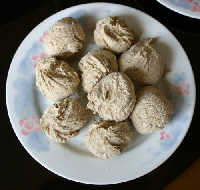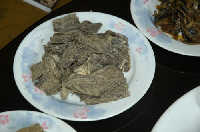| |
Four Treasures of Tibetan Food
( 2005-10-27 )
According to the Tibetan custom, the tea is drunk in separate sips, and after each sip the host refills the bowl to the brim. Thus the guest never drains his bowl yet it is constantly topped up. If the guest does not wish to drink, the best thing to do is leave the tea untouched until it is time to leave and then down the bowl, except for only a small amount. In this way Tibetan etiquette is observed and the host will not be offended.
Tsamba
 Tsamba, cooked glutinous rice pounded into paste, is the basic food of Tibetans. It is made of highland barley, which is dried, then fried and grounded into powder. When eating, one should first pour a little buttered tea into a bowl. Next add some ghee, fine milk sediments, and white sugar into it, and then put the tsamba flour into the bowl. Hold the bowl with the left hand, and thoroughly mix the ingredients with the right hand. Finally, mold the dough into small balls for eating. Other ingredients may also be added according to taste. Tsamba, cooked glutinous rice pounded into paste, is the basic food of Tibetans. It is made of highland barley, which is dried, then fried and grounded into powder. When eating, one should first pour a little buttered tea into a bowl. Next add some ghee, fine milk sediments, and white sugar into it, and then put the tsamba flour into the bowl. Hold the bowl with the left hand, and thoroughly mix the ingredients with the right hand. Finally, mold the dough into small balls for eating. Other ingredients may also be added according to taste.
Air-dried meat
Air-dried meat is a special kind of food in Tibet. Tibetans hang pieces of meat in a shady and cool place at the end of the year, to let them air-dry naturally. On February or March of the next year, the meat pieces can be eaten.
Barley wine
 Barley wine is made of highland barley, which is the favorite of Tibetan, especially in festivals. It's easy to make this wine. First, cook the washed barley, then add distiller's yeast into it after it is cool, and place it into a pottery jar.Sealthe jar, and cover it with a Tibetan blanket to increase the temperature to make the barley ferment in the jar. Unseal the jar after several days, add an appropriate amount of pure water in the jar, and then seal it again for one or two days more days. The barley wine will appear light yellow, taste mild and slightly sweet and sour, and contain little alcohol. Barley wine is made of highland barley, which is the favorite of Tibetan, especially in festivals. It's easy to make this wine. First, cook the washed barley, then add distiller's yeast into it after it is cool, and place it into a pottery jar.Sealthe jar, and cover it with a Tibetan blanket to increase the temperature to make the barley ferment in the jar. Unseal the jar after several days, add an appropriate amount of pure water in the jar, and then seal it again for one or two days more days. The barley wine will appear light yellow, taste mild and slightly sweet and sour, and contain little alcohol.
There is a custom to follow when drinking. Instead of drinking up, the guest should first drink a little and let the host immediately fill up; the guest drinks a little again and the host fills in once more, and so on. When the glass is filled the fourth time, the guest should drink up; only in this way will the host feel respected. The more the guest drinks, the much happier the host will be as he or she will view this as meaning excellent wine brewing.
In pasture areas, besides tsamba and cooked wheaten food, herders always eat the "red" and "white" food. The "red food" refers to meat and the "white food" refers to milk. In summer, they eat white, and in winter, red. The well-known snacks in pasture areas are mutton eaten with the right hand, baked sheep intestines, and air-dried meat.
In farming areas, highland barley, wheat, and peas are the main food, as well as dairy products, yam, corn, buckwheat, soybean, kidney bean, and meat. And there are many wild animals, such as hare, deer, roe, boar and pheasant, which can supply rich meat.
The taste of Tibetan food is light and mild. Most of dishes are seasoned only with salt, shallot, and garlic, without any other spicy flavoring, which represents the food culture of returning to nature.
|
|

